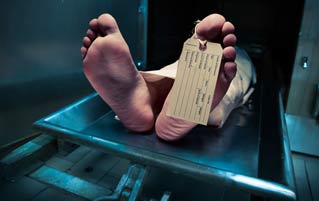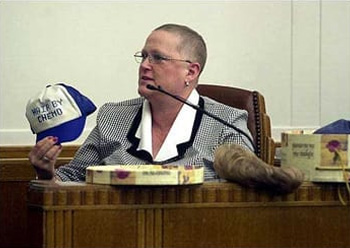The 6 Worst Ways People Made Money (Includes Boiling Kids)

Excelling in your career takes dedication, ingenuity, and bathing in the entrails of your fellow man. If that last bit seems out of place, then sit back, relax, and allow us to demonstrate once again that there's more than one way to make a buck, and like half of them involve things that would make the devil's butthole tighten involuntarily.
Enriqueta Marti Sold Potions Made Of Boiled Children
At the turn of the 20th century, Barcelona's population exploded. This was partially due to the return of Spanish-American War vets, and partially due to an influx of poverty-stricken immigrants looking to take advantage of the city's bargain-basement prices on drugs and prostitution. It was an environment where Enriqueta Marti fit right in: Not only was she a prostitute herself, but she also specialized in acquiring (read: kidnapping) children. See, Marti was a practicing witch doctor ...

Ooh, ee. Ooh ah ah.
... and some of her clients had very ... particular tastes.
What a destitute population most likely to trip face-first into a puddle of tuberculosis needed more than anything was hope, and Marti happily sold it to them: She made miracle potions that promised to do everything from improving your love life to making you practically immortal.
And here's the catch: Marti's kidnapping business and Marti's witchcraft business were one and the same. Her potions were made by boiling down children. Probably the most popular concoction of all, the one that promised immortality, was nothing more than the fresh blood of an 8-year-old. Marti wasn't above partaking of that one herself, earning her the nickname the Vampire of Barcelona.

She also kept bags of child bones to responsibly use every part of the child.
Her little artisanal apothecary went out of business in 1912, when a neighbor spotted Teresita Guitart Congost, the latest in a long line of kidnapping victims, peeking out of a window in Marti's flat. Police stormed the apartment, rescued Teresita, and whisked Marti off to jail. Teresita reported that Marti had kept her fed by forcing her to cannibalize other children. Marti died prior to sentencing -- the cause of death was either terminal uterine cancer or a terminal mob of angry fellow inmates, depending on who you ask and how literally you believe karma should be applied.

And we're sure the girl who escaped Marti's gingerbread house went on to live a completely normal and sane life.
Miyuki Ishikawa Starved Babies For Profit
In the 1940s, Japan was a rough place to live, with a plethora of impoverished couples who just couldn't feed their children. Luckily for them, Miyuki Ishikawa was there to help.

Bad luck is a kind of luck.
Ishikawa was a rarity in World War II-era Japan: a female graduate of the University of Tokyo, and the successful director of Kotobuki Hospital. Ishikawa offered hope to hopeless parents, in that she would take in their little bundles of joy and care for them until the couples could get back on their feet ... for a fee, of course. Presumably said fee was quite nominal (given the fact that it was being charged to people so poor that they were willing to hand over their own flesh and blood), but that didn't matter, because Ishikawa planned to keep her costs low.
Real, real low.

Q. How many dead babies does it take to turn a profit?
A. Keep reading.
Because she never planned to give the babies back, find them loving homes, or even so much as feed them. She simply tossed them in a room to starve to death (or worse) and hired a crooked doctor named Shiro Nakayama to write up fake death certificates, in case authorities became suspicious. It's estimated that the duo was responsible for the deaths of as many as 169 newborns in their "baby farming" scheme, which is a term we could have died without knowing.
Ishikawa's crops dried up in 1948, when the police discovered a literal pile of dead babies and traced the bodies to Kotobuki Hospital. She and her cohorts were arrested and served four years in prison. That's not a typo. Four.

"Technically, she didn't kill anyone. She just refrained from feeding them."
Ma And Pa Copeland Buried Hired Transients On Their Farm
Ray and Faye Copeland were your average elderly farm couple, eking out a living from the land in 1890s Missouri.
Wait, did we say 1890s? We meant 1980s. Damn dyslexia.

Actually, can we double check that?
Ray had somewhat of a reputation as an untrustworthy sack of cocks, thanks to his penchant for purchasing cattle with bad checks and then selling them off for a hefty profit (not a difficult feat, considering he paid zilch for them to begin with).
With sellers becoming wise to his chicanery, Ray needed a way to stretch the con. So he and Faye traveled to a mission for the homeless in Springfield and lured in a transient with the promise of $50 per day. Their new farmhand thusly hired, the couple set up a checking account in his name and sent him out to buy cattle ... with checks. Checks written against the bank account of a homeless man. By the time the checks bounced, the Copelands had already sold off the livestock and were rolling deep in the way that only '80s Missourian farmers could understand.

"Only silk pajamas with the trapdoor bottoms from now on."
When it appeared that the jig might be up, the Copelands fired their faithful farmhand -- by "blast him in the back of the head with a rifle" -- and headed back to Springfield to start the process all over again.

"No, we just sent them to a uh, nicer farm with bigger fields and other hobos to play with."
Eventually they were apprehended and sentenced to life in prison. When the feds scoured the Copelands' farm during their investigation, they discovered the remains of five men -- four buried in the dirt floors of barns, and one tied to a concrete block and dropped into a well. In the house, they found a patchwork quilt that Faye had been sewing from strips of their victims' clothing, because you can take the murderer out of the grandma, but you can't take the grandma out of the murderer.
The "Skin Hunters" Created Corpses To Sell To Crooked Funeral Homes
Our story begins in the Polish town of Lodz, with the skin hunters of the surprisingly cutthroat local funeral parlor trade. Here, the term "skin" refers to a fresh corpse, while the "hunter" is the medical professional who tips off their undertaker of choice, in exchange for a cut of the profit from the funeral.
Enter doctors Janusz Kuklinski and Pawel Wasilewski, who had a comfortable little skin-hunting racket going with a local group of undertakers back in the '90s. So comfortable, in fact, that they soon brought paramedics Karol Banas and Andrzej Nowocien into the fold.

They were men whose souls were as black as their names were unpronounceable.
Once the newcomers got a taste of that sweet, sweet corpse money, it didn't take them long to realize that the surest way to increase their proceeds was to increase their output. So they began taking matters into their own hands, driving around the block a few extra times with dying patients in tow, or even speeding up the process by injecting them with literally heart-stopping amounts of muscle relaxant.
The Polish media blew the scandal wide open in 2002, leading to a five-year investigation and trial that ended with Kuklinski and Wasilewski being sentenced to six and five years in prison, respectively, while Banas was sentenced to 25 years and Nowocien was awarded a life sentence. He later boasted to his cellmate that he should have been given "a medal by the national health system in view of the number of old people he had taken off its hands." Most disturbingly of all, it appears the foursome was just the tip of an iceberg consisting of more than 40 medical professionals and undertakers who had been carrying on a widespread skin-hunting scheme for more than two decades.
The Panama Canal Railway Company Sold The Pickled Corpses Of Its Employees To The Highest Bidder
The construction of the Panama Canal required a nearly unfathomable amount of manpower, and before that could even start, they first needed to build the Panama Railway. Laying track through 48 miles of snake-infested jungles, disease-infested swamps, and terrain so treacherous that it could swallow men whole like the Swamp of Sadness was no easy feat. In fact, it's estimated that the construction of the canal was paid for with 500 lives for every mile of its length. These were mostly poor laborers from the U.S., Europe, Colombia, China, and the Caribbean who arrived with dollar signs in their eyes and precisely nothing to identify them to their next of kin. To presumably not your surprise, they began keeling over like overworked (and malaria-infected) lemmings.

Also, their diet consisted entirely of malaria-infected lemmings.
Obviously, this posed a problem for the Panama Railroad Company. Never let it be said, however, that the PRC didn't know how to turn life's lemons into history's most ghastly lemonade. You see, there was no shortage of medical schools that would pay top dollar for cadavers on which to hone their students' skills. Thus opened a whole new revenue stream for the PRC: The company pickled the corpses of its countless fallen workers in wooden barrels, then shipped them off for med students to pry open like some kind of horrific Kinder Egg.

They kind of left that verse out of the song.
Robert Courtney Made Millions Selling Watered-Down Medicine To Cancer Sufferers
To the people of Kansas City, Missouri, Robert Courtney appeared to be the very model of a respectable citizen. He was a loving family man, a deacon at his church, and a successful pharmacist who helped countless customers cope with the ills that an unloving universe tends to lob our way. In actuality, Robert Courtney was a heartless, money-grubbing son of a bitch whose medical ethics would make Martin Shkreli queasy.

Courtney, pictured here looking exactly how you'd think.
Courtney targeted cancer sufferers undergoing chemotherapy, because life and pharmaceutical pricing hadn't already fucked them quite enough. Whenever Courtney filled a prescription for chemotherapy drugs like Taxol and Gemzar, he first diluted them with a hefty dose of purified water, thereby earning himself a quick couple hundred bucks per dose. It's estimated that in the nearly 12 years Courtney was carrying on his scheme, he diluted 98,000 prescriptions, affecting 4,200 patients. While his patients died in their beds, wondering why their medication wasn't working, Courtney was out tooling around in his Mercedes, buying his wife diamond rings, and donating a cool million to his church -- hey, that should offset all the evil, right? It's such a nice, round figure.

Why, it's nearly 250 bucks per screwed cancer patient!
Of course, Courtney being a pharmacist and not an accountant, his ledgers didn't make a whole lot of sense (namely, he was selling a shit-ton more drugs than he was buying). Investigations into his books led to investigations into the medicine itself, and it quickly came to light that prescriptions procured from Courtney's pharmacy were about as effective as Facebook likes. He was slapped with a $2.2 billion judgment and a 30-year sentence in the big house, where presumably even convicted murderers think he's "kind of a dick."
Also check out The 6 Most Clueless Assholes To Ever Exploit Tragedies and The 8 Most Shameless Attempts to Cash In On 9/11.
Subscribe to our YouTube channel, and check out How Robots Already Tried (And Failed) To Take Our Jobs, and other videos you won't see on the site!
Follow us on Facebook, and we'll follow you everywhere.